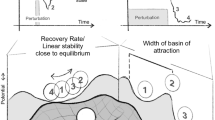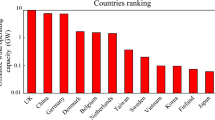Abstract
Concentrations of outdoor radon-222 (222Rn) in temperate grazed peatland and deciduous forest in northwestern Turkey were measured, compared, and modeled using artificial neural networks (ANNs) and multiple nonlinear regression (MNLR) models. The best-performing multilayer perceptron model selected out of 28 ANNs considerably enhanced accuracy metrics in emulating 222Rn concentrations relative to the MNLR model. The two ecosystems had similar diel patterns with the lowest 222Rn concentrations in the afternoon and the highest ones near dawn. Mean level (5.1 + 2.5 Bq m−3 h−1) of 222Rn in the forest was three times smaller than that (15.8 + 9.7 Bq m−3) of 222Rn in the peatland. Mean 222Rn level had negative and positive relationships with air temperature and relative humidity, respectively.


Similar content being viewed by others
References
Conen, F., & Robertson, L. (2002). Latitudinal distribution of radon-222 flux from continents. Tellus, B54, 127–133.
Feichter, J., & Crutzen, P. J. (1990). Parameterization of vertical tracer transport due to deep cumulus convection in a global transport model and its evaluation with 222Radon measurements. Tellus, 42B, 100.
Griffiths, A. D., Zahorowski, W., Element, A., & Werczynski, S. (2010). A map of radon flux at the Australian land surface. Atmospheric Chemistry and Physics, 10, 8969–8982.
Grossi, C., Vargas, A., Camacho, A., López-Coto, I., Bolívar, J. P., Xia, Y., et al. (2011). Inter-comparison of different direct and indirect methods to determine radon flux from soil. Radiation Measurements, 46, 112–118.
Hirao, S., Yamazawa, H., & Moriizumi, J. (2010). Estimation of the global 222Rn flux density from the Earth’s surface. Japanese Journal of Health Physics, 45, 161–171.
Hirsch, A. I. (2007). On using radon-222 and CO2 to calculate regional-scale CO2 fluxes. Atmospheric Chemistry and Physics, 7, 3737–3747.
Mihci, M., Buyuksarac, A., Aydemir, A., & Celebi, N. (2010). Indoor and outdoor radon concentration measurements in Sivas, Turkey, in comparison with geological setting. Journal of Environmental Radioactivity, 101, 952–957.
Oikawa, S., Kanno, N., Sanada, T., Ohashi, N., Uesugi, M., Sato, K., et al. (2003). A nationwide survey of outdoor radon concentration in Japan. Journal of Environmental Radioactivity, 65(2), 203–213.
Papachristodoulou, C., Ioannides, K., & Spathis, S. (2007). The effect of moisture content on radon diffusion through soil: assessment in laboratory and field experiments. Health Physics, 92(3), 257–264.
Persson, B. R. R., & Holm, E. (2011). Polonium-210 and lead-210 in the terrestrial environment: a historical review. Journal of Environmental Radioactivity, 102, 420–429.
Schery, S. D., & Huang, S. (2004). An estimate of the global distribution of radon emissions from the ocean. Geophysical Research Letters, 31, L19104.
Takala, J. M. (1995). Radon fundamentals. Radiation protection course. Nov 13–16, Saskatoon, Saskatchewan.
Williams, A., Chambers, S., Zahorowski, W., Crawford, J., Matsumoto, K., & Uematsu, M. (2009). Estimating the Asian radon flux density and its latitudinal gradient in winter using ground-based radon observations at Sado Island. Tellus, B61, 732–746.
Zahorowski, W., Chambers, S., & Henderson-Sellers, A. (2004). Ground based radon-222 observations and their application to atmospheric studies. Journal of Environmental Radioactivity, 76, 3–33.
Zhang, K., Wan, H., Zhang, M., & Wang, B. (2008). Evaluation of the atmospheric transport in a GCM using radon measurements: sensitivity to cumulus convection parameterization. Atmospheric Chemistry and Physics, 8, 2811–2832.
Acknowledgments
The authors warmly thank Abant Izzet Baysal University (grant no: BAP-2011.03.02.425) and The Scientific and Technological Research Council of Turkey (TUBITAK) (grant no: COST-CAYDAG-109Y186) for funding this study.
Author information
Authors and Affiliations
Corresponding author
Rights and permissions
About this article
Cite this article
Evrendilek, F., Denizli, H., Yetis, H. et al. Monitoring spatiotemporal variations of diel radon concentrations in peatland and forest ecosystems based on neural network and regression models. Environ Monit Assess 185, 5577–5583 (2013). https://doi.org/10.1007/s10661-012-2968-3
Received:
Accepted:
Published:
Issue Date:
DOI: https://doi.org/10.1007/s10661-012-2968-3




